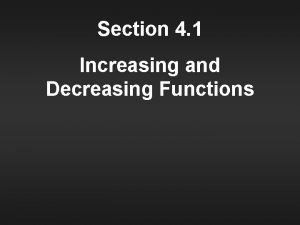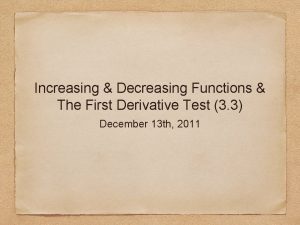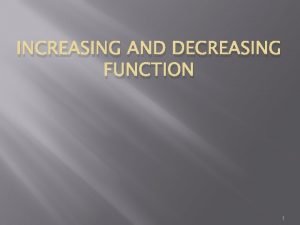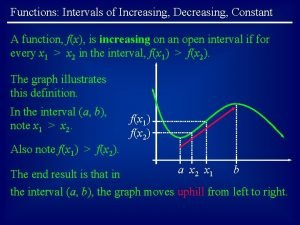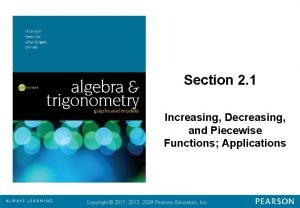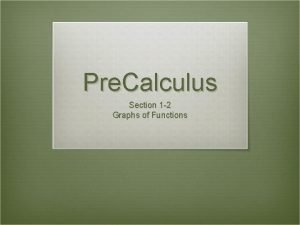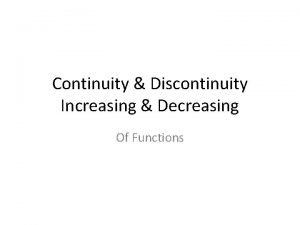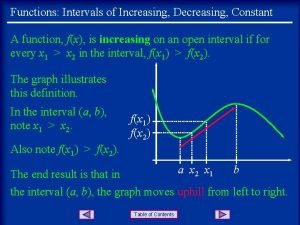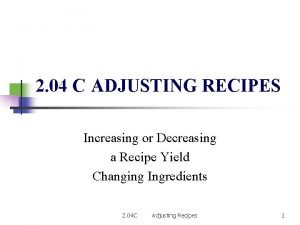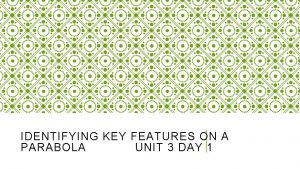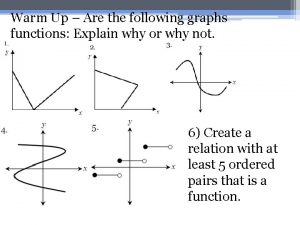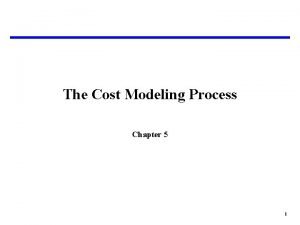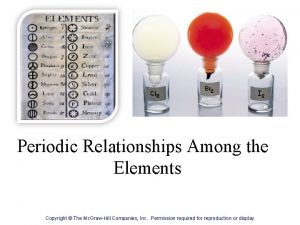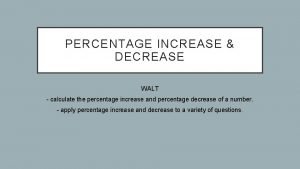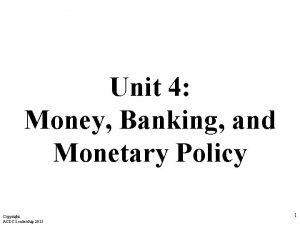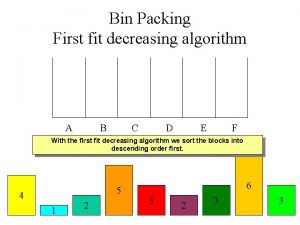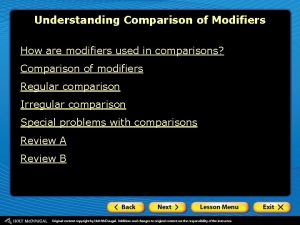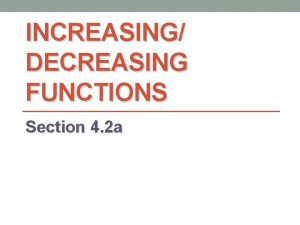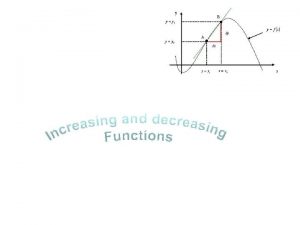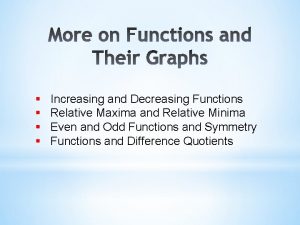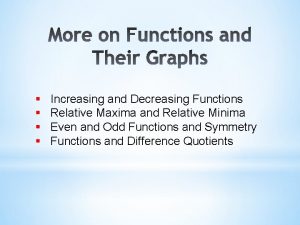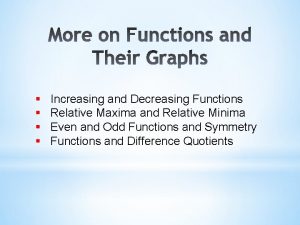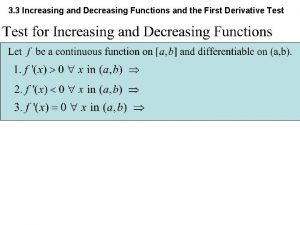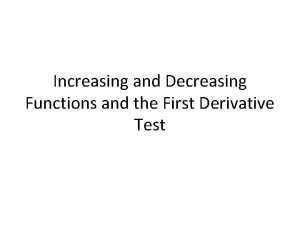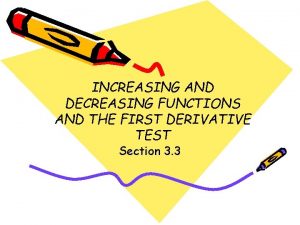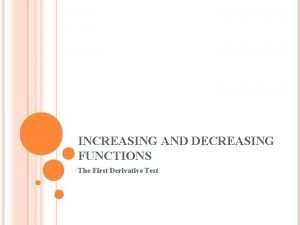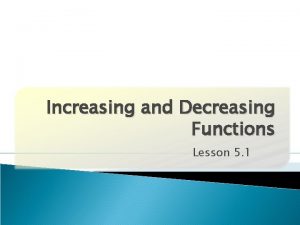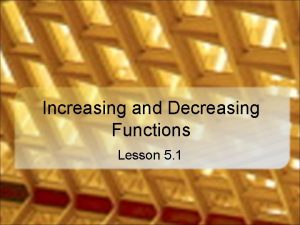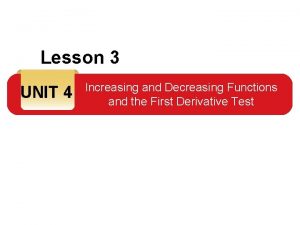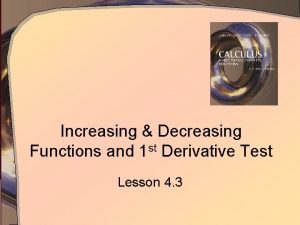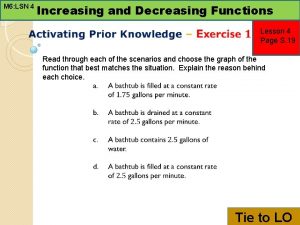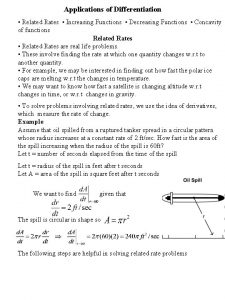Section 3 3 Increasing and Decreasing Functions and


























- Slides: 26

Section 3. 3 – Increasing and Decreasing Functions and the First Derivative Test

How Derivatives Affect the Shape of the Graph Many of the applications of calculus depend on our ability to deduce facts about a function f from in information concerning its derivatives. Since the derivative of f represents the slope of tangents lines, it tells us the direction in which the curve proceeds at each point. Thus, it should seem reasonable that the derivative of a function can reveal characteristics of the graph of the function.

Increasing and Decreasing Functions The function f is strictly increasing on an interval I if f (x 1) < f (x 2) whenever x 1 < x 2. The function f is strictly Decreasing on an interval I if f (x 1) > f (x 2) whenever x 1 < x 2. D f(x) Decreasing Increasing B A C x

How the Derivative is connected to Increasing/Decreasing Functions When the function is increasing, what is the sign (+ or –) of the slopes of the tangent lines? POSITIVE Slope When the function is decreasing, what is the sign (+ or –) of the slopes of the tangent lines? NEGATIVE Slope D f(x) B A C x

Test for Increasing and Decreasing Functions Let f be differentiable on the open interval (a, b) If f '(x) > 0 on (a, b), then f is strictly increasing on (a, b). If f '(x) < 0 on (a, b), then f is strictly decreasing on (a, b). If f '(x) = 0 on (a, b), then f is constant on (a, b).

Procedure for Finding Intervals on which a Function is increasing or Decreasing If f is a continuous function on an open interval (a, b). To find the open intervals on which f is increasing or decreasing: 1. Find the critical numbers of f in (a, b) AND all values (a, b) of x in that make the derivative undefined. 2. Make a sign chart: The critical numbers and x-values that make the derivative undefined divide the x-axis into intervals. Test the sign (+ or –) of the derivative inside each of these intervals. 3. If f '(x) > 0 in an interval, then f is increasing in that same interval. If f '(x) < 0 in an interval, then f is decreasing in that same interval. 4. State your conclusion(s) with a “because” statement using the sign chart. A sign chart does NOT stand on its own.

Example 1 Use the graph of f '(x) below to determine when f is increasing and decreasing. f is increasing when the derivative is positive. f ' (x) Increasing: (-∞, -1) U (3, ∞) f is increasing when the x derivative is f is positive. decreasing when the derivative is negative. Decreasing: (-1, 3)

White Board Challenge The graph of f is shown below. Sketch a graph of the derivative of f.

White Board Challenge Find the critical numbers of:

Example 2 Find where the function increasing and where it is decreasing. is Domain of f: All Reals Find the critical numbers/where the derivative is undefined Find the derivative. Find where the derivative is 0 or undefined Find the sign of the derivative on each interval. -1 0 2 Answer the question

Example 2: Answer The function is increasing on (-1, 0)U(2, ∞) because the first derivative is positive on this interval. The function is decreasing on (-∞, -1)U(0, 2) because the first derivative is negative on this interval.

Example 3 Use the graph of f (x) below to determine when f is increasing and decreasing. f is decreasing Notice how the function changes from increasing to f is increasing decreasing at x=-3. But when since the -3 is not outputs infunction’s the domain of the are gettingit larger function, is not a as the input. Thus, critical point. increases. critical points are not the only points to include in sign charts. Increasing: (-∞, -3) when the function’s outputs are getting smaller as the input increases. f (x) x Decreasing: (-3, ∞)

Example 4 Find where the function it is decreasing. is increasing and where Domain of f : All Reals except -1 Find the critical numbers/where the derivative is undefined Find the derivative. Find where the derivative is 0 or undefined The function does not have any critical points: the derivative is never equal to 0 and the derivative is only undefined at a point not in the functions domain (x=-1). Even though -1 is not a critical point, it can still be a point where a function changes from increasing to decreasing. ALWAYS include every x value that makes the derivative undefined on a sign chart (even if its not a critical point). Find the sign of the derivative on each interval. -1 Answer the question

Example 4: Answer The function is decreasing on (-∞, -1)U(-1, ∞) because the first derivative is negative on this interval. Make sure not to include -1 in the interval because it is not in the domain of the function.

White Board Challenge Find the maximum and minimum values attained by the given function on the indicated closed interval:

Critical Values and Relative Extrema Remember that if a function has a relative minimum or a maximum at c, then c must be a critical number of the function. Unfortunately not every critical number results in a relative extrema. A new calculus method is needed to determine whether relative extrema exist at a critical point and if it is a maximum or minimum.

How the Derivative is connected to Relative Minimum and Maximum When a critical point is a relative maximum, what are the characteristics of the function? The function changes from increasing to decreasing When a critical point is a relative minimum, what are the characteristics of the function? The function changes from decreasing to increasing D f(x) B A C x

The First Derivative Test Suppose that c is a critical number of a continuous function f(x). (a) If f '(x) changes from positive to negative at c, then f(x) has a relative maximum at c. f(x) Relative Maximum f '(x) > 0 f '(x) < 0 c x

The First Derivative Test Suppose that c is a critical number of a continuous function f(x). (b) If f '(x) changes from negative to positive at c, then f(x) has a relative minimum at c. f(x) f '(x) < 0 f '(x) > 0 Relative Minimum c x

The First Derivative Test Suppose that c is a critical number of a continuous function f(x). (c) If f '(x) does not change sign at c (that is f '(x) is positive on both sides of c or negative on both sides), then f(x) has no relative maximum or minimum at c. f(x) f '(x) > 0 c x No Relative Maximum or Minimum f '(x) < 0 c x

Example 1 Use the graph of f '(x) below to determine where f has a relative minimum or maximum. f ' (x) Find the Critical Numbers x Make a sign chart and Find the sign of the derivative on each interval. Apply the First Derivative Test. -1 Relative Maximum: @ -1 3 Relative Minimum: @ 3

Example 2 Find where the function on 0≤x≤ 2π has Domain of f: relative extrema. 0≤x≤ 2π Find the critical numbers Find the derivative. Find where the derivative is 0 or undefined Find the sign of the derivative on each interval. Find the value of the function: 0 2π/3 4π/3 2π Answer the question

Example 2: Answer The function has a relative maximum of 3. 826 at x = 2π/3 because the first derivative changes from positive to negative values at this point. The function has a relative minimum 2. 457 at x = 4π/3 because the first derivative changes from negative to positive values at this point.

Example 3 Find the relative extrema values of Find the critical numbers Find the derivative. -1 All Reals Find where the derivative is 0 or undefined The derivative is undefined at x=-3, 0 Find the sign of the derivative on each interval. -3 . Domain of f: 0 NOTE: 0 is not a relative extrema since the derivative does not change sign. Answer the question

Example 3: Answer First find the value of the function: Now answer the question: The function has a relative maximum of 0 at x = -3 because the first derivative changes from positive to negative values at this point. The function has a relative minimum of -1. 587 at x = -1 because the first derivative changes from negative to positive values at this point.

White Board Challenge Find the intervals on which the function below is increasing or decreasing. BONUS: How many critical numbers are there?
 Aims and objectives of increasing and decreasing functions
Aims and objectives of increasing and decreasing functions Lesson 4 increasing and decreasing functions
Lesson 4 increasing and decreasing functions First derivative increasing decreasing
First derivative increasing decreasing Strictly increasing and decreasing functions
Strictly increasing and decreasing functions Intervals of increasing and decreasing
Intervals of increasing and decreasing Increasing decreasing and piecewise functions
Increasing decreasing and piecewise functions Cognitive synonym
Cognitive synonym How to find increasing and decreasing intervals on a graph
How to find increasing and decreasing intervals on a graph Increasing and decreasing intervals
Increasing and decreasing intervals Increasing and decreasing intervals
Increasing and decreasing intervals Increasing and decreasing recipes
Increasing and decreasing recipes Identify the end behavior
Identify the end behavior Explain pictures
Explain pictures Increasing at a decreasing rate
Increasing at a decreasing rate Periodic table with phases
Periodic table with phases Decreasing electronegativity
Decreasing electronegativity Increase decrease calculator
Increase decrease calculator Order of increasing first ionization energy
Order of increasing first ionization energy First fit decreasing bin packing
First fit decreasing bin packing Decreasing response time almost always
Decreasing response time almost always Decreasing turnover time operating room
Decreasing turnover time operating room Drag truss
Drag truss Money supply and interest rate
Money supply and interest rate First fit decreasing algorithm
First fit decreasing algorithm Which modifier can be used in the comparative degree?
Which modifier can be used in the comparative degree? Britain diamond mining and increasing labour control
Britain diamond mining and increasing labour control Evaluating functions
Evaluating functions
